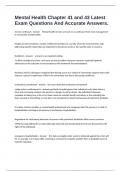Mental Health Chapter 41 and 43 Latest
Exam Questions And Accurate Answers.
Service continuum - Answer Mental health services are seen on a continuum from crisis management
to community mental health
People are best served by a variety of different providers in a variety of service environments, each
addressing specific needs that are important to the person at his or her specific point in recovery.
Recidivism - Answer a return to an inpatient setting
-is often considered a failure, and many service providers interpret a person's repeated inpatient
admissions as the outcome of noncompliance with treatment recommendations
Davidson and his colleagues recognized that having access to a variety of community supports that could
improve a person's experience of life in the community was key to decreasing recidivism
involuntary commitment - Answer the most restrictive treatment environment
-judge orders confinement in a locked psychiatric hospital against the individual's will, when there is
clear and convincing evidence the person is a danger to self or others, the individual is deemed
incapable of taking care of his or her basic needs to maintain health and safety, or the individual has
been accused of committing a crime but is not competent to stand trial because of psychiatric disability
It is often a family member or mental health professional who recognizes that the person is in need of
hospitalization and begins the process of involuntary hospitalization.
Regulations for involuntary admission of persons with psychiatric disabilities differ across countries
-WHO has long lobbied for an internationally observed and standardized level of care that protects the
rights of the individual
emergency hospitalization - Answer the state can legally order a person detained against his or her will
for, on average, 3 to 5 days while a hearing is convened to evaluate whether there is probable cause to
hold the individual
,-In these cases, the criteria to hold a person against his or her will are the same as those for involuntary
commitment
Involuntary outpatient commitment - Answer a less restrictive, court-ordered mechanism that requires
a person to submit to outpatient services.
-These decisions are usually made because the person has a history of decompensation that has
required involuntary commitment to inpatient facilities, has a history of severe and persistent psychiatric
disability and lacks insight into the need for treatment, or has a demonstrated risk of homelessness or
incarceration
voluntary admissions - Answer people who voluntarily present for treatment, agree to stay as long as
treatment is deemed necessary, and may sign out at any time unless the mental health providers
determine that the admission status be changed from voluntary to involuntary status
-In the latter case, health providers must demonstrate due cause for their decision
Approximately two-thirds of all mental health hospital admissions
When an individual directly applies for voluntary admission, an initial assessment is completed and a
suggestion is made for level of care based on factors such as safety, need for medication titration, and
symptomology
Inpatient mental health settings - Answer For many individuals in crisis, admission to an inpatient
psychiatric setting can prevent suicide, support the person's management of his or her psychiatric
disability, and improve functioning
-residential settings and most are structured, secure, and controlled environments that address the
primary goals of crisis stabilization and safety.
allows people to work through a crisis in a safe environment, identify with others who share similar
problems, understand and come to terms with their illness, and begin treatment.
acute care - Answer typically very brief, but it is often the beginning of a person's recovery
-The primary mission is to save lives, which often involves suicide prevention
-inpatient
,The length of stay is very short, so occupational therapy services in this setting include programs that
focus on helping people find ways to engage and participate in occupations both within and when they
leave the hospital setting
-OT assessment based on functional skills can predict those individuals who will require readmission,
leading to implementing services to support the occupational needs of those with lower functional levels
and increasing their success after discharge
-It is important for practitioners in acute care settings to connect people to community resources in
order to help them build a new routine outside of the hospital that includes physical activity
suicide rates - Answer In the US, self-harm as the 10th highest cause of death overall and the 3rd
highest for ages 10 to 44
-Worldwide, suicide in persons aged 15 to 29 is the second highest cause of death
In the United States, older adults take their lives at a disproportionally higher rate.
-People older than the age of 65 commit 18% of all suicides, yet this group makes up only 13% of the U.S.
population
Fewer than 1% of all adults who seek treatment for mental health problems utilize inpatient services
-It is a service that cannot be eliminated because of the serious consequences of acute mental crisis on
personal and psychological safety.
inpatient hospitalization - Answer a brief structured intervention focused on transitioning into less
restrictive care environments
Inpatient intervention is a combined effort of a team of care providers including a psychiatrist, medical
doctors, and nurses who manage psychotropic medications and other medical conditions
-Social workers, counselors, occupational therapy practitioners, and other therapists work to facilitate
recovery, educate people about how to navigate a complicated mental health system, help identify
needed supports, and introduce service users and families to available resources that can support the
recovery process
specialized hospitalization - Answer address the specific needs of children and adolescents, as well as
individuals with substance abuse, eating disorders, dementia, and other conditions
, Sheppard Pratt Health System in Baltimore
-has specialized inpatient hospital programs subdivided by life stage (i.e., child, adolescent, young adult,
adult, geriatric) or disability (crisis stabilization, eating disorder, psychotic disorder, co-occurring
disorders, etc.)
-Although all programs share the basic inpatient hospitalization goals of safety, education, motivation,
and transition, there are additional goals specific to the needs of specific population
As people age, they may need to mourn for accumulating losses and often begin to lose their sense of
efficacy.
-These challenges contribute to depression and the difficulty in coping with the day-to-day life issues
experienced by older adults with mental health issues
-Practitioners in geriatric specialty units are expected to communicate with long-term care providers to
share techniques and approaches that worked best with the person they treat
State hospitals and forensic mental health hospitals also provide inpatient services and are important
components of the continuum of car
-These settings are designed to meet the needs of individuals who are complex or challenging and those
who have been convicted of crimes
Intervention team - Answer The composition of the intervention team in inpatient settings depends on
client demographics and the intervention philosophy of the setting.
Funding sources require that all settings provide medical and psychiatric interventions requiring
physicians, psychiatrists, and nurses.
-Social workers or licensed counselors provide family intervention, process group therapy, and
placement and referral support.
-Other team members provide occupational therapy, recreational therapy, and expressive therapies such
as art, music, and dance or movement
Specialty units often have additional staff for particular needs
-Dietitians are integral team members on units treating people with eating disorders






